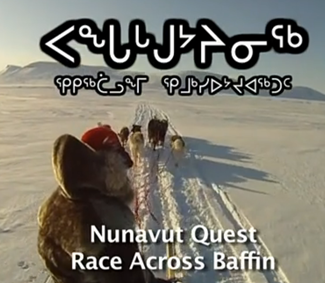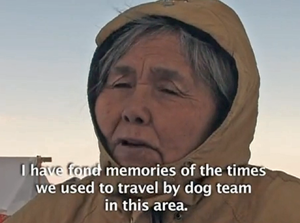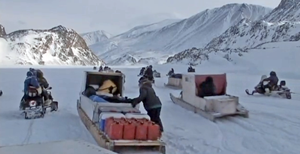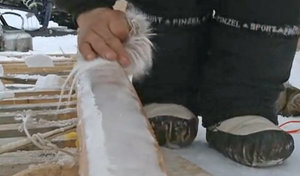The Fan Hitch Volume
14, Number 2, March 2012
Journal
of the Inuit Sled Dog
|
In
This Issue.... Navigating This Site
The Fan Hitch, Journal of
the Inuit Sled Dog, is published four times
a year. It is available at no cost online
at: https://thefanhitch.org.
The Fan Hitch welcomes your letters, stories, comments and suggestions. The editorial staff reserves the right to edit submissions used for publication. Contents of The Fan Hitch are protected by international copyright laws. No photo, drawing or text may be reproduced in any form without written consent. Webmasters please note: written consent is necessary before linking this site to yours! Please forward requests to Sue Hamilton, 55 Town Line Rd., Harwinton, Connecticut 06791, USA or mail@thefanhitch.org. This site is dedicated to the Inuit Dog as well as related Inuit culture and traditions. It is also home to The Fan Hitch, Journal of the Inuit Sled Dog. |
Media Review....
Nunavut Quest: Race
Across Baffin
reviewed by Sue Hamilton
The idea to have dog team race was born January 1999 in Arctic Bay as one of the activities to commemorate the creation of Nunavut (April 1, 1999). With much cooperative effort for organizing, rule making and fundraising, in just a little over two months the event went from a suggestion to reality as the organizers were gratified to learn that communities across Baffin Island were eager to join in this celebration. Four teams from Pond Inlet, one from Clyde River, three from Hall Beach, three from Igluliq and three from Arctic Bay left the starting line in Arctic Bay on their way to Igluliq on April 13th. The rules at that time were simple: a team of ten to twelve dogs in the traditional fan hitch formation were to pull a qamutiq of 12-14 ft (3.7 to 4.3 m) in length carrying gear for overnight camping on the land. The order of finish was determined by the least amount of time traveled between the checkpoints where teams and their support crews (traveling well in advance of the dog drivers) set up camps for the night. Those first participants expressed a desire to continue the Nunavut Quest on an annual basis as a means of healing and encouraging greater use of dog teams. In the ensuing years, the rules expanded based on the experiences of each previous year’s event and the start-finish line has moved amongst communities so that all could enjoy and take pride on the cultural heritage of dog team travel.*
Piksuk Media’s six-episode documentary, Nunavut Quest: Race Across Baffin, is based on the 2010 (eleventh annual) running of the Nunavut Quest dog team race. While the rules (from 4 in 1999 to 32 in 2010) and the prizes may have become more elaborate, the essence of the event has remained the same – to share pride in culture and honor the tradition of dog team travel. Although the competitive spirit exists, Piksuk's documentary demonstrates that it does not prevail as both entrants and their support crews are seen working together to have a successful race. And as Lee Narraway, the Quest's official timer since the first race, comments, during the race the dog drivers don’t care to know their daily times.
In episode 1, Into the Wild, seventeen teams assemble at the starting line in Pond Inlet. Some have driven their dogs for as many as 11 days of hard arctic miles, arriving only a day before the start. Along with the entrants, the support crews, numbering over a hundred, travel along. Some are youngsters and many others are Elders excited to once again travel on the land as they did in their youth, some wishing to visit places they hadn’t been in decades, others curious to go where they had never before been; all eager to share their experiences and stories of a lifestyle long gone, but not forgotten. In this episode you will see scenes of the community feast, music and dancing to celebrate the start of the race, the ceremony to draw the numbered bibs and an explanation of the equipment that entrants are required to carry on their qamutiit.
Episode 2, Wall of Snow, focuses on the support teams and the events that begin the start of each day’s run. Each day begins with a prayer and a discussion of what to expect enroute to the next checkpoint. The weather, the wind, sea ice conditions and the safest routes dominate conversations. One entrant is interviewed and he describes how he came to enter the Quest. He talks about Inuit Dogs of old and modern times. The roles of the support crews are described in detail. About 45 snow machines carrying people age 12 to 76 leave camp about an hour ahead of the dog team drivers to set up the next camp, pitching tents, setting the dogs’ picket lines. The official timer, awaits a short distance outside of camp to record the arrival of each team and check them in. By the end of day 1, the teams have traveled 50 km (31 mi) in a blizzard and deep, soft snow.
Episode 3, Dogged Pursuit, describes day 2 of the race with team drivers and support crews alike enduring high winds creating ground blizzard conditions and poor visibility making travel dangerous. A driver looses his team while untangling the fan hitch lines. The team is stopped by another driver while the unlucky driver runs on foot to catch up. At times "water sky" (Also known as ice blink, this is a phenomenon where open water at the floe edge can be seen at a distance as a dark gray reflection on the undersides of clouds.) dictates that all the travelers must avoid dangerous ice and polar bears by staying close to shore. The surface here is tough on all the qamutiit, but one in particular has an especially rough time. It’s owner mixes ancient and modern technology by icing plastic runners. The rugged surface traveled has blasted off the ice which means the driver must stop, melt water and reapply the ice to the runners in order to create less drag for his dogs to overcome. There is more description of the ancestral use of dogs and a member of one driver's support crew describes preparing dog food and feeding the team. By the end of day two on the trail south to Clyde River, 85 km (53 mi) have been covered – a long day.
Every minute of these episodes is packed
with fascinating details. And there are views of
Baffin communities, beautiful scenery, dogs on the go in good and
bad weather, and on the picket line being fed. Where
people are speaking in Inuktitut, the translations
appear as easy to read English subtitles at the
bottom of the screen. Episodes 4, 5 and 6 will be reviewed in the June 2012 issue of The Fan Hitch.
*Information for this
history of the Nunavut Quest came from a 2002
article written by Niore Iqalukjuak of Arctic Bay,
one of the Nunavut Quest’s original organizers.
Ed. |



